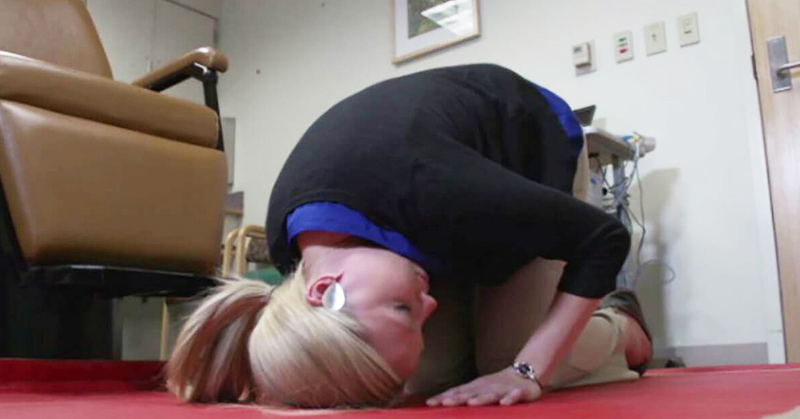Vertigo is a frightening condition. A tilt of the head could send the patient into a dizzying and terrifying sensation. It’s debilitating and can strike at any moment, even in the middle of the night. Although there are medications and other treatments available, some patients do not find them effective. Fortunately, the Half Somersault Maneuver developed by Dr. Carol Foster has given some incredible results to long-time sufferers. [1]
What is Vertigo?
The inner ear has three interconnected canals and gravity sensors. These canals are capped by bed of crystals that can become dislodged and enter any of the canals. When this dislodgement occurs, the crystals may buildup and cause a mechanical disorder. The system starts to function incorrectly and the tilting motions of the buildup crystals cause intense dizziness for the patient.
“Everything about you will move, it will spin,” explains Sue Rickers, a long-time patient of this condition. “I couldn’t drive, I couldn’t walk, I had to hold onto the wall — and it was very, very scary.”
Standard treatments include the Epley maneuver and the Semont maneuver, as well as medications including anticholinergics, antihistamines, benzodiazepines, calcium channel antagonists, dopamine receptor antagonists, and anti-nausea depending on the type of vertigo and symptoms being treated. [2][6]
Different kinds of vertigo include:
Ménière’s disease
Meniere’s disease causes symptoms that can last for up to 24 hours. The vertigo is often so severe it results in nausea and vomiting. It may also cause hearing loss, ringing in the ears, and a feeling of fullness in the ear canal.
Vestibular neuritis
This is also called vestibular neuritis. This type has a sudden onset and can create unsteadiness, earaches, nausea, and vomiting. It is usually the result of an infection, such as a cold or the flu, that has spread to the vestibular nerve, which controls balance.
Benign paroxysmal positional vertigo (BPPV)
This form of vertigo is triggered by certain head movements as a crystal buildup shifts in the inner ear canals.
Labyrinthitis
This kind of vertigo causes dizziness and feeling of movement when the patient is staying still. It’s usually caused by an ear infection, and it is often accompanied by fevers and earaches. [3]
Benign Paroxysmal Positional Vertigo (BPPV) is the most common form of vertigo. When it comes to BPPV this maneuver has had some overwhelmingly positive results. For other forms of vertigo, this maneuver, unfortunately, is not effective.
The Half Somersault Maneuver
She explains how the buildup of particles cause vertigo; therefore, she has experimented with a twisting motion to release these particles and stop vertigo in its tracks. She developed an exercise so simple her patients, and anyone else, can do them at home. [4]
Otolaryngologist Dr. Carol Foster MD, Director of the Balance Laboratory from the University of Colorado Denver, discovered a new method to stop vertigo when she developed the condition herself. She had Meniere’s disease, which gave her bouts of intense dizziness and nausea for hours almost every day. A surgery to cut the nerve in her ear and treated the symptoms for a while, until the spinning resumed, worse than before. Foster made it her mission to fight vertigo and made this breakthrough.
How to Do the Half Somersault Maneuver
- Come to the floor in a kneeling position.
- Tilt your head back and look at the ceiling—don’t worry if your dizziness increases momentarily.
- While staying on your knees, put your hands on the floor in front of you and let your head hang loose, with your chin slightly tucked in. The top of your head should be parallel to the floor, even touching it if comfortable.
- Turn your head to either your right or left elbow, depending upon which ear you need to treat.
- Hold this position until the spinning sensation is gone or for 30 seconds.
- Lift the head quickly with the hands still on the ground. The head should be aligned with the back and still turned to the affected side.
- Lift the head fully upright. [5]
You may need to repeat this exercise a few times for it to take effect. Give yourself a fifteen-minute break between each set. For a visual demonstration, see Dr. Carol Foster’s video here.
“My wife had Vertigo for third time in three years and it didn’t get any better even after seeing an ENT and even after being prescribed with medicine for 30 days. She did this maneuver once and her vertigo disappeared. This is so simple yet very effective,” said Thangavelu Arun, patient of Dr. Foster.
“Thank you very much Dr. Foster! I have performed only one set and I felt more steady already. What I did was just wait for fifteen minutes and then did it again. What a relief!” said Melanie Bonnet, another patient. [1]
When to See a Doctor
Chronic dizziness could be a symptom of a larger issue. If you suffer from this, see a doctor as soon as possible. Once you receive a proper diagnosis for vertigo, ask your doctor about performing this exercise before trying it out.
Let us know how it works out!
Disclaimer: This information is not intended to be a substitute for professional medical advice, diagnosis or treatment and is for information only. Always seek the advice of your physician or other qualified health provider with any questions about your medical condition and/or current medication. Do not disregard professional medical advice or delay seeking advice or treatment because of something you have read here.
Sources
- Half Somersault Maneuver.
- “Meclizine.” Drugs. Sanjai Sinha, MD. December 21, 2018.
- “Pharmacological treatment of vertigo.” NCBI. T.C Hain, M. Uddin. 2003.
- “ I Feel Dizzy: Peripheral Vertigo.” Healthline. Janelle Martel. May 16, 2017.
- “Carol Foster, MD Vertigo Treatment Oct 11.” Youtube. University of Colorado Denver. October 14, 2013.
- “How do you do the half-somersault or Foster maneuver to treat vertigo?” WebMD. November 24, 2018.
- ” Dizziness and Vertigo- Treatment .” Merck Manual.

